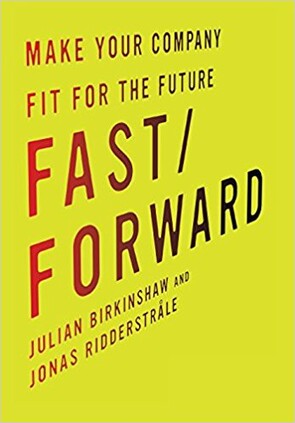|
“In a bureaucracy and a meritocracy, emotions are seen as negatives or irrational, while an adhocracy thrives on positive and personal engagement” — Julian Birkinshaw & Jonas Ridderstrale By William Ballard In our last article, we talked about the management model known as meritocracy and how it favors competence and intelligence over position or title -- as well as over the emotional element. In this article we are going to talk about the third management model known as an adhocracy, which is a management model that doesn’t strive to favor one component over another, but rather, does its best to fill the gaps that the other models leave open. Related Article: 3 Management Models of The Past, Present, and Future (Part 1 of 3) With that said, let’s do a quick recap. What’s a good example of a meritocracy organization that was not mentioned in the last article? Well, consider the hit TV series known as House — staring Hugh Laurie as Gregory House, M.D., the main character of the American medical drama. Dr. House lead the Diagnostic department, which was made of a team of highly skilled, trained, and competent diagnosticians at the fictional Princeton-Plainsboro Teaching Hospital in Princeton, New Jersey. His character has been described as someone who has a distaste for humanity, who believes that selfishness is the only motivation for human action or behavior, a narcissist, rude, and many other poor character traits that one could possess. His unorthodox diagnostic methods, radical motives, and uncompromising rationality resulted in many conflicts between him and his colleagues. Not to mention that he was often portrayed as lacking sympathy for his patients by often stating his mantra of beliefs — “Everybody lies.” Related Article: 3 Management Models of The Past, Present, and Future (Part 2 of 3) Now, I bring this particular example up because I want to show you something about meritocracy type organizations. What you have to keep in mind is that Dr. House’s team of doctors were are also extremely competent in their particular fields, and all of them — including Dr. House — were constantly competing with one another to see whose professional diagnostic idea was more sound than the other. Some might say that House’s condescending, rude, narcissistic approach to the way he lead his team was actually a way to motivate and inspire them to really put their best foot forward, and “encourage” them to give it everything they got and work to their full-potential, which they did many times over. However, this type of management approach would not be acceptable in today’s workplace environment. For one, people’s feelings are bit more sensitive today than what they were several years back, when this management model was the de facto standard. The Management Model of The FutureAdhocracy is ideally suited for organizations that operate in highly unpredictable business environments. In fact, at the core of this particular management model, it favors actions over position or knowledge. For example, consider this: When faced with difficult decisions, organizations that operate under a bureaucratic management model often defer their most difficult choices and decisions to their boss or department head. For organizations that operate under a meritocracy based management model, they tend to reflect and discuss their views with their colleagues before making any irrational decisions. Related Article: The Key to Succeeding in The New Business Landscape of The Future (Part 1 of 2) However, those that make up an adhocracy based organization tend to prefer to act and take low-risk by experimenting and determining what course of action should be taken based off the results of such an experiment. Now, with all that said, it is important to also bear in mind that knowledge and formal positioning of the organizational chart is not overlooked or ignored in adhocracy ran firms, but rather, it means that, at the essence of every problem or challenge faced, the decision of doing something is more valued than “wasting” the time for reflection or deferring problems and challenges upward.
It was also mentioned in Future Shock (AFF) and then later picked up by strategy guru Henry Mintzberg in his book, Structure in Fives (AFF) — not to mention Robert Waterman’s work, “Adhocracy: The Power to Change.” (AFF) The common pattern or theme throughout these literary works is that adhocracy is a flexible, informal way of managing an operation that is forever changing, developing, and evolving. Now, the thing about these particular writings is that they tend to only speak about how adhocracy is considered to be the complete opposite of a bureaucracy, and fail to even mention the meritocracy management model altogether. Therefore, what we have to keep in mind is that, when it comes to a bureaucracy and a meritocracy, emotions are seen as negatives or irrational constructs and provide no true value as to how to manage an organization. Related Article: The Key to Succeeding in The New Business Landscape of The Future (Part 2 of 2) Think of it like this: For years people were being taught about “time management.” However, only recently have people began to realize how the concepts of time management is really nothing more than irrational or delusional thinking. You see, it's impossible to manage time — it is impossible to manage something that is outside of the control of your influence. No, you can’t manage time, you can only manage yourself and how or what you do within or through time. You can only manage tasks (actions). Now, with that said, when it comes to a bureaucratic or meritocratic organization, the minds that came up with these management concepts viewed the ability of managing human emotions as being equal to the irrational thinking of being able to manage time. In other words, just as much as we can’t manage time, we can’t control or manage how or what others will feel. Response vs. React (And “I” Statements)The truth is: There is a lot to be said about these ideas. In fact, before we go on about the adhocracy management model let me quickly mention two concepts that are most commonly known within in psychology and psychiatric (or therapeutic) circles. First, the idea of responding vs. reacting. The fact of the matter is: Most people tend to react more than they respond. You see, in most cases, when someone hurts our feelings what we tend to do is act on our immediate feelings, which is to react, or better yet, attack. We immediately go on the defensive and say to ourselves subconsciously, “He/she hurt my feelings, now I need to get revenge or hurt them back.” This particular course of action is all about acting without thinking, which usually leads to doing things that we will later regret. That brings me to the better path, the path less traveled. Related Article: Professional Goals: To Move Up, Step Out The better way of dealing with someone that has hurt our feelings is to choose to respond rather than react. What that means is this: Before you take any kind of action, what you need to do is think and process what has just taken place. First, ask yourself why that particular thing hurt your feelings. Process whether or not you could have misinterpreted what someone said or did, or perhaps consider the possibility that you might be reading into something that isn't or wasn’t there. Once you do that, that leads me to my next psychiatric and therapeutic concept I want to share with you referred to as “I” Statements. Instead of reacting, or better yet, overacting to something that you may have misinterpreted — or read into that which wasn’t there — you give an “I” statement to the person that hurt you. It works like this: You say, “I feel ________ [insert emotion] when you _________ [insert specific behavior]. In the future, I would like … [desired outcome].” In short, when we decide to respond rather than react what we are doing is deciding to think before we act. We are deciding to let our thoughts influence our behavior rather than our feelings influencing our actions. Adhocracy — The Concept of Managing Actions Infused With EmotionNow, I took that brief little detour through therapy lane to make a point. You see, it has been discovered that within adhocracy run organizations, action without conviction rarely produces superior results. You see, whether we want to accept it or not, emotions are everywhere (even if they are suppressed), and what the management leaders of the past failed to realize or accept is that emotions are interwoven within the realms of knowledge (competence), actions, and organizational position. In fact, it is our internal convictions that fuel our actions, influence our levels of knowledge, and attach itself to the authority or position we hold. As I mentioned before, just as it is impossible to manage time, it is equally impossible to manage someone else’s emotions. However, just as we are only able to manage ourselves and what we do in or through time, as department heads and management leaders, we may not be fully able to manage how our teams may feel, but we can manage the actions our teams make. Related Article: 5 Stages to Developing a Strong Mind That Can Overcome Any Obstacle or Challenge You Face in 2018 The truth is: There are many different practical ways managers can effectively influence the confidence, hope, optimism, and resilience of their team members. Therefore, look at adhocracy as not just the management model that favors action, but rather action infused with emotion. In the entrepreneurial environment of the present and future, and because of the influx of access to information, the principles of bureaucracy (position overall all else) and meritocracy (competence is better than position) can make the decision making process that much more lengthy and, therefore, devastating. In order to counter this, the answer is adhocracy.
|
|
Comments









